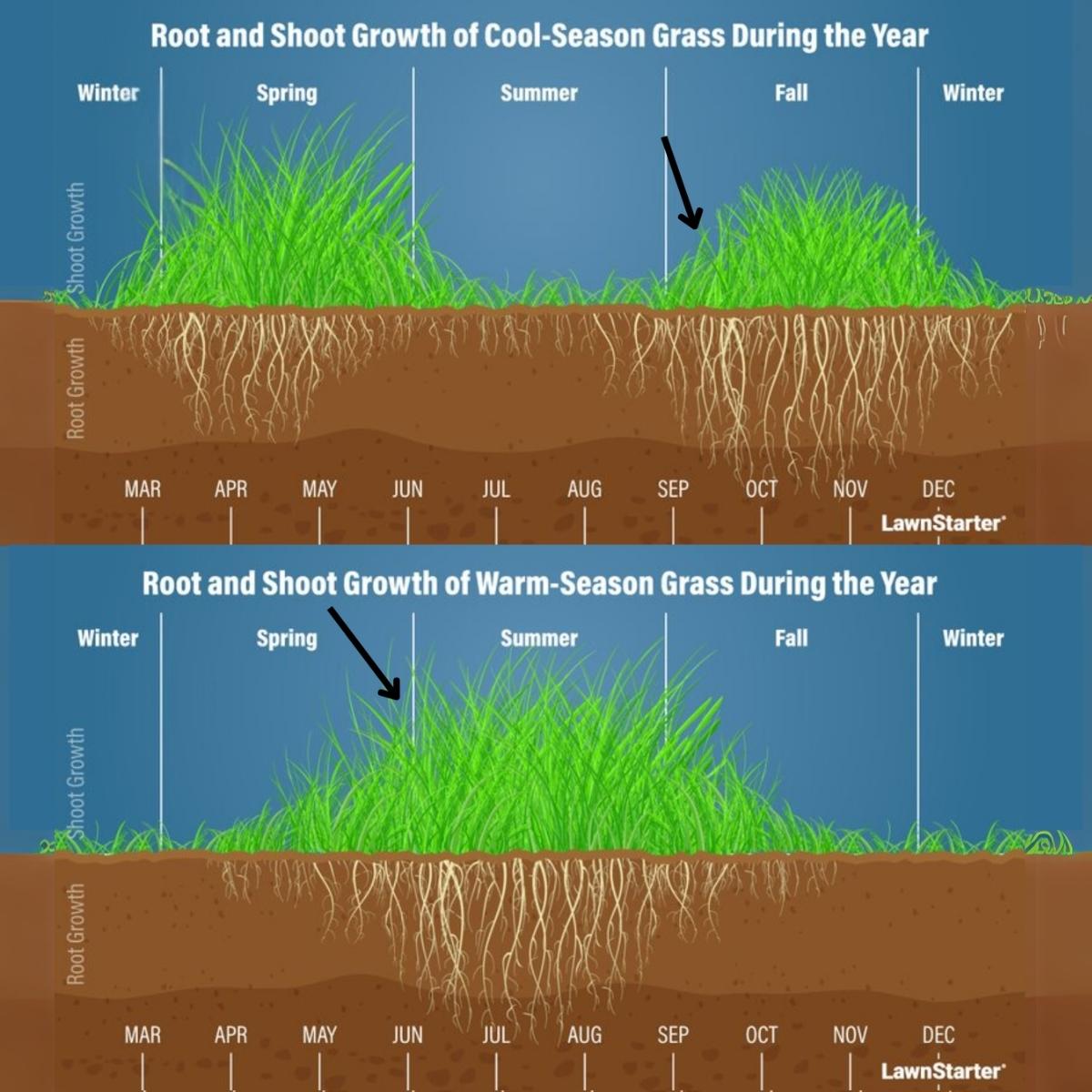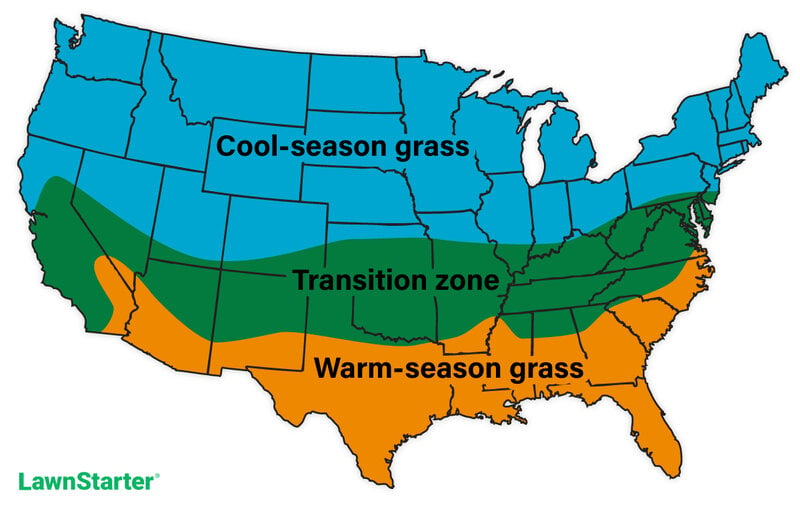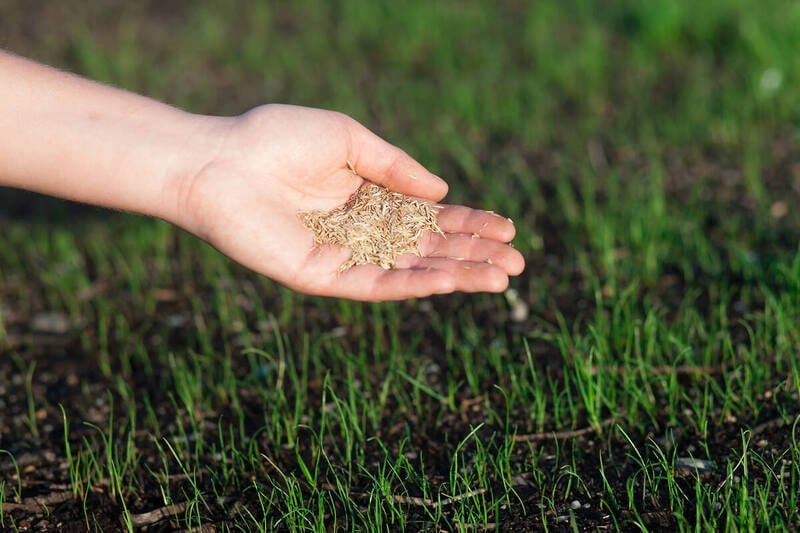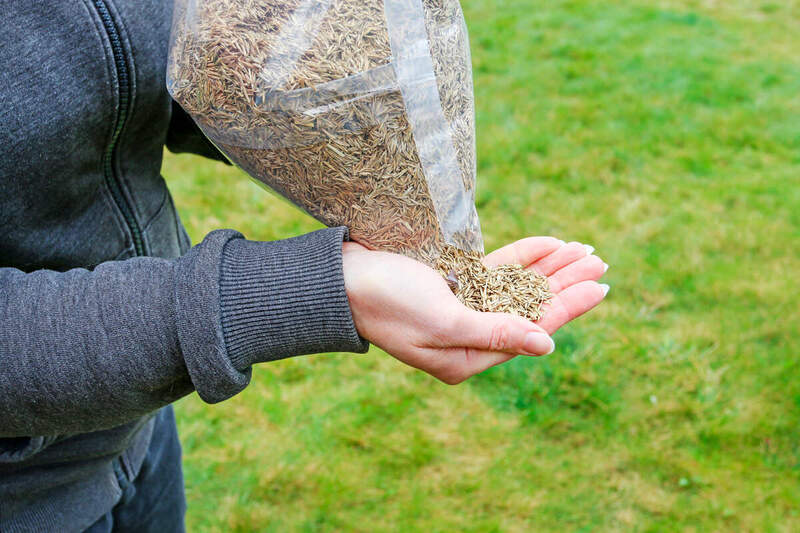
For cool-season grasses, the best time to plant grass seed is late summer to early fall. But if you have warm-season grass like me, it’s best to plant in late spring to early summer.
You can still plant outside of these recommended timeframes, but you’ll have a lower chance of success. So, it’s best to get it right from the start if you want to have a lush green lawn.
Cool-Season vs. Warm-Season Grasses

The biggest factor when determining the best time of year to plant grass seed is the type of grass, whether cool-season or warm-season. So, if you’re planting a lawn from scratch, you must first identify the type of grass you want. If you’re overseeding an existing lawn, check which type of grass you have.
Cool-season grasses have two main growth periods: fall and spring. Since they grow best in cold climates, they require a greater degree of attention in the summer months, as they need lots of water to prevent dormancy. Here are the most common cool-season grasses:
- Fescue grass (tall fescue and fine fescues)
- Perennial ryegrass
- Kentucky bluegrass
Warm-season grasses, which have one growth period from late spring to early fall, grow fastest on hot summer days. They struggle in cold weather, and may go dormant in winter. Examples of common warm-season grasses include:
- St. Augustinegrass
- Centipedegrass
- Bermudagrass
- Zoysiagrass
- Bahiagrass
Note: Check out our article How to Choose the Right Grass for Your Lawn to select the best type of grass for your home.
See Related: How to Plant Grass Seed
Plant Warm-Season Grass Seeds in Late Spring/Early Summer

The best time to plant grass seed for warm-season grasses is either late spring or early summer once the soil temperatures reach 65 F. You can plant warm-season turf after its ideal planting window, but it’s not recommended since the new grass seedlings will be stressed due to the heat.
Early spring may seem like a good time for seeding because the ground is still wet and the weather is cool. But it’s also the time when weeds actively spread. And you can’t apply weed control solutions like post-emergent herbicides because they could harm your new grass.
Here are more reasons to aim for late spring to early summer when planting warm-season grasses:
- Ample time for grass to establish: Planting warm-season grass as early as late spring will give it time to establish. Doing so can help your grass endure the summer heat and prepare for winter dormancy. Even established warm-season grass has poor cold tolerance. So, imagine how the seedlings would fare when faced with cold weather.
- Warm temperatures: Planting too late into summer will make your tender seedlings face the heat of summer before they have a chance to establish. While warm-season grasses tolerate heat very well, they need time to grow strong roots to survive the heat. So, plant in late spring to early summer when it’s warm, but not scorching hot.
- Rain: Drying out is the enemy of germination. Since there’s still a fair amount of rain during the period between late spring and early summer, it will help your seedlings stay moist.
Plant Cool-Season Grass Seeds in Late Summer/Early Fall

Cool-season grasses sprout best in late summer or early fall when the soil temperature is around 50 to 65 F (and the air temperature is around 60 to 75 F). Note, though, that your window for planting can change depending on how close you are to the transition zone:
- Above the transition zone, homeowners can seed their lawns as early as Aug. 15 but no later than Oct. 1.
- If you’re closer to, or in, the transition zone, wait a bit longer before seeding. You can seed from around Labor Day to late October.
Pro Tip: Check the estimated date of the first frost for your area, as the latest you can plant grass seeds is 45 days before that date. Any later than that can kill tender seedlings and prevent grass seeds that haven’t sprouted yet from germinating until spring.
Below are more reasons why late summer or early fall is the best time to plant grass seeds for cool-season types:
- Perfect temperatures. The air and soil temperatures in late summer to early fall are cool enough for planting cool-season grasses. However, the soil is still a bit warm from the summer months, which helps promote germination.
- Frequent rain. Rain helps keep grass seeds moist, which is key to fast and successful germination. And it tends to rain often during the last few weeks of summer up into fall.
- Less stress on the grass. Since cool-season grasses are cold-tolerant, they can survive winter easier than the scorching summer heat. They’ll also need less watering during winter, so you don’t have to spend a lot on your water bill just to keep your new grass alive.
- Less weed pressure. While winter annuals and other common types of weeds can still compete with your grass, it isn’t as bad as weed growth in the spring.
How to Care for New Grass
After successfully planting your grass seed, you must continue caring for your new grass. To help it grow healthy and develop a strong, deep root system, do the following to help your grass seeds establish and grow into a beautiful lawn:
- Keep the soil moist, but not soggy
- Add starter fertilizer
- Water frequently
- Limit foot traffic
- Do the first mow
- Control the weeds
I recommend reading our guide How to Care for New Grass for a more comprehensive explanation of each step.
FAQ About When to Plant Grass Seed
If you plant grass seeds too late in the season, they could suffer from poor germination rates, leading to patchy growth. This happens because the seeds cannot establish a strong root system due to extreme heat or cold. Even if they don’t die due to harsh weather conditions, the stressed seedlings will be very susceptible to common lawn diseases.
Yes, you can. Some homeowners think it’s too early to plant grass seed in the winter, but there’s actually a process called dormant seeding. The seeds remain dormant in the soil during cold weather and germinate once the soil warms up in the spring.
Note, though, that although it can give you a head start, you must consider the risks. For example, your seedlings may die if the ground takes a long time to thaw or rot if they stay on wet soil for too long.
Annual and perennial ryegrass seeds can germinate in as little as five days. Tied in second place, Bermudagrass and buffalograss can both germinate in as little as a week.
Let a Pro Do the Work
Proper timing is not the only key when it comes to planting grass seeds. You’ll also need to prepare the area and choose the right grass type, among other things. So, if it sounds overwhelming, it actually is. That’s why it’s best to consult with a local landscaping pro who knows the perfect time to plant grass seed in your area.
Sources:
- Missouri Botanical Garden: Winter Annual Weeds
- Ohio State University: Choosing the Right Turf Grass for Your Ohio Lawn
- University of Georgia: Basic Turfgrass Management for Georgia
- University of Illinois Extension: Don’t Seed a Cool Season Lawn in the Summer
- University of Massachusetts Amherst: Turfgrass Response to Water Deficits
Main Image Credit: Infographic by Juan Rodriguez created using Canva Pro